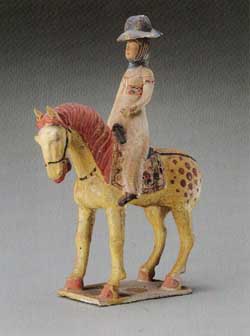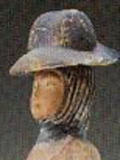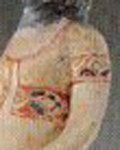| Horse and female rider in Tang Dynasty (618-907) | |
 |
Glazed
earthenware with pigments Wth
a pull of her left hand, this elegant horsewoman restrains a spotted
horse with fiery red mane and red hooves to match. The figure was
sculpted and then glazed except for the face, which is painted.
|
During the Sui dynasty (581-619), the mili 𮳾X (a body-long veil designed to block the stranger's gaze, became popular for ladies of the imperial and ducal house-holds who rode horses on public roads.
|
 |
| The short-sleeved jacket that falls above the waist is embellished with an embroidered border that complements those at the wrist. |  |
| Sources of information: China - Dawn of a Golden Age, 200-750AD, The Metropolitan Museum of Art, New York Yale university Press | |